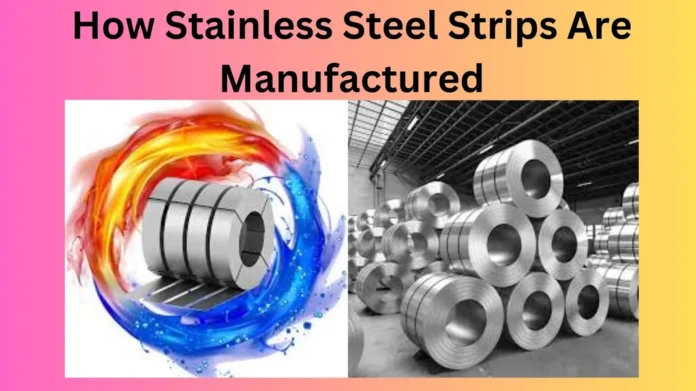Stainless steel sheets are vital in a variety of construction, aerospace, automotive and electronic industries. The thin, flat-rolled sheets are well-known by their superior resistance to corrosion as well as their impressive strength and appealing appearance.
This article will go over the step-by-step process of manufacturing of these strips as well as methods used to ensure high-end quality and desirable properties of the product. The process involves a number of complex processes and meticulously developed methods to guarantee that the product is of high quality. the stainless steel strip.
Step-By-Step Manufacturing Process Of Stainless Steel Strips:
The following are the key processes that are used during the production process of the strips.
Melting and Refining
The initial step in the production of stainless steel strip involves the refining and melting process of the raw materials. The main components of stainless steel are iron, chromium and nickel, as well as other alloying elements. They are precisely weighed and then mixed in a melting furnace to create the chemical composition that is desired.
Iron, chromium and nickel ore comprise some of the meticulously chosen raw ingredients that are used into stainless steel. This is to eliminate impurities and ensure the consistency. In a furnace, such as the electric arc furnace or an induction furnace, the other alloying components are exposed to extreme temperatures, which causes them to melt and create an molten steel pool.
Continuous Casting
Once the stainless steel molten is at the right temperature, it goes through continuous casting, which results in semi-finished products such as billets or slabs. Continuous casting is the process of pouring hot steel into a water-cooled mold to create an un-solidified slab. This method helps to keep the temperature and consistency that the metal has, which results in better mechanical properties and less segregation.
Continuous casting is extremely efficient, allowing the continuous production of stainless steel billets or slabs and ensuring consistent quality. Utilizing a mold that is water-cooled and molten steel, the material is able to solidify quickly, resulting in an improved microstructure that significantly improves the mechanical properties of the final product.
Hot Rolling
The next step to consider involves hot rolling in which semi-finished products are formed into smaller gauge materials. The billet or slab is then heated before being passed through a set of rollers in order to reduce the thickness slowly.
Steel made of stainless is exposed to extreme heat and pressure when it is hot rolled. The rolling process lengthens the steel’s grains which aligns them with the rolling. This improves durability and strength and makes the stainless steel suited to a variety of applications that require high mechanical properties. Hot rolling can also remove surface imperfections or defects that may have developed in the continuous casting process making sure that the surface is smooth and smooth surface appearance.
Annealing
After the hot rolling process the strip of stainless steel is subjected to an annealing process to ease internal stress and increase its elasticity. It involves heating the steel strip up to a predetermined temperature, and then holding it for a set period of time and then a controlled cooling. The process softens the strip and improves its working capacity which makes it much easier to further process the strip.
It is an essential process in the manufacturing of stainless steel strips process because it helps to remove the deformation and strain caused by the hot rolling process. The controlled cooling and heating cycles that occur during annealing alter the microstructure, making stainless steel flexible and easy to form.
Cold Rolling
Cold rolling is an essential process in the production of stainless steel strips. the annealed strip goes through several chilling mills. This minimizes the size of the strips and provides those desired properties including tensile strength, and hardness. Cold rolling can also enhance the finish of the surface and guarantees precision in dimensional measurement.
It’s done at temperatures that are ambient The strip is rolled through several tandem mills. Each passing reduces the thickness of the strip till the gauge you want is attained. Cold rolling will harden the stainless steel to make it more durable and stronger.
Pickling
This sheet of stainless steel is then subjected to picking to eliminate any surface scale or oxide layers that are formed when rolling it cold and hot. Pickling is the process of soaking in acid solutions that is typically a nitric or hydrofluoric acid mix. The chemical process removes the impurities, and also provides an even surface for future procedures.
It is a process which removes oxide layers as well as other impurities off on the steel’s surface. It is a reaction between the acid and oxides, causing them to dissolve and leaving a clean surface. This is an essential step to increase the resistance to corrosion of the strip and to ensure the adhesion of coatings and other treatments that could be later applied in manufacturing.
Skin Pass Rolling
Skin pass rolling is an option to increase the flatness of the strip and the surface’s finish. In this method, the strip is pushed through specially designed rollers that exert the right quantity of pressure and tension. Skin pass rolling can also help to improve the mechanical properties of the strip and decreases the chance of defects such as waviness or buckles.
It’s usually done after the cold rolling process and prior to any final finishing. The process involves using work rollers with a certain roughness to apply pressure to the strip of stainless steel. This pressure assists in removing defects and stress in the strip’s surface. This results in the strip is smooth and flat.
Slitting
The long strip is passed through a slitting machine in order to create stainless steel strips with various sizes. This involves cutting the broad strip in narrow strips that are of the required size. This process is essential in meeting particular customer needs and cutting down on the waste of materials.
Slitting machines are equipped with round blades, or knives which precisely cut the large stainless-steel strip in thinner strips. The size of the strips may be changed according to customer specifications or to the intended use. This allows stainless-steel producers to provide different sizes of strips to meet the diverse demands of markets. It also helps ensure efficient utilization of the material, reducing loss and maximizing production costs.
Final Remarks
Each step plays an important impact on the final quality and properties of the foils. Since demand for stainless steel foils grows across various industries, advances in manufacturing methods continue to improve the effectiveness as well as the quality of these crucial material. The stainless steel strip production process guarantees that the end users receive top-quality strips for a variety of applications, which makes it an integral part of the modern industrialization.















